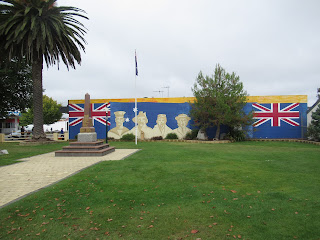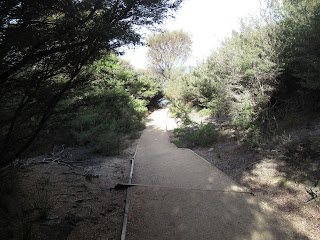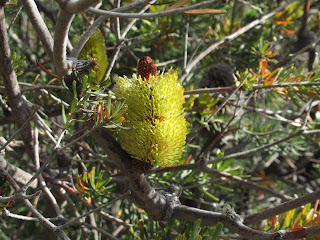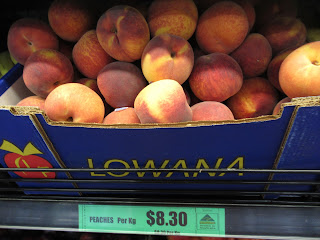I am simultaneously finishing a travel blog about the fantastic 4.5 month long trip Steven and I took last fall and early winter to Armenia, Georgia, Azerbaijan, and much of Central Asia before our final six weeks in Spain and Portugal and a few days in the Netherlands. If you're interested in checking that exciting adventure out, here's the link: www.bergersadventures6.blogspot.com
My friend, Diane, and I had to get up at the ungodly hour of 4 am to leave Melbourne to catch a 7 am flight to Launceston on the Australian island of Tasmania, located off the mainland's southern coast. The island has been described as a place of wild beauty colored by a tragic past, in large part because it became a dumping ground for convicts from Great Britain who had often been transported for minor crimes.
After picking up a rental car in Launceston in the northern part of the island, we began driving northeast toward St. Helens on the coast, passing through rainforests and fertile valleys. I was so relieved that Diane was a careful driver as there are more accidents involving tourists on Tasmania's roads than anywhere else in Australia. That was because many of the island's roads are narrow and curves can be tight, especially in the mountainous inland regions.
I was so glad Diane obliged my curiosity and stopped when we saw this unusual sculpture. The shelter indicated the reserve had been given to the community by Athol and Joan McLennan, a pioneering couple who were born about 1910 and made many contributions to agriculture and the Scottsdale community.
What amused him were the number of people, like us, who stopped to take pictures! There was a dozen explanations but really it was just a big tree that fell and he encouraged people to come up with their own explanation.
In case you've never seen a Tasmanian license plate, here was what one looked like!
This was known as The Tree that Came to Life as when it crashed to earth in a storm, the tree died. Years later, though, it was evident that it provided habitat for millions of other living things. A deep hole at the base of a broken branch was a nesting space for a family of ring-tailed possums and Tasmanian Devils found shelter in the fire-hollowed trunk. A dead tree? No. It was a cradle of life.
From the park's visitors' center we had stunning views of Great Oyster Bay where we strolled toward Sleepy Bay.
Just as we'd learned and witnessed recently on New Zealand's South Island, the effects of climate change were also evident here with water temperatures having increased by 2 degrees Celsius since the 1950s which has meant a difference of life and death for marine life.
One of the effects of global climate change has been changing ocean currents as Tasmania's east coast is now more influenced by the warmer, nutrient-poor waters of the East Australian Current.
Giant kelp forest once flourished in the cool, nutrient-rich waters along this coastline. However, due to the influx of warmer, nutrient-poor waters, these spectacular underwater forests are fast disappearing. The alarm is that many marine species rely on giant kelp for shelter, food or breeding habitat. Many warmer water marine species have recently arrived in Tasmanian waters.
The long-spined urchin has been one of the prickly invaders that arrived and became a major threat to Tasmania's coastal reefs and rock lobster, abalone and eco-tourism industries. The urchins are the 'lawn mowers of the sea' who transform healthy and productive kelp beds into lifeless bare rock. One of the few predators capable of breaking int the spiny shells of the long-spined urchin is only older, larger, southern rock lobster.
To put it mildly, it had been a very long day since leaving Melbourne early that morning but we had fun exploring for a few minutes in the very old Morris General Store in the charming town of Swansea and picking up some dinner fixings before collapsing at our B&B. We did have sticker shock, mind you, when we saw bananas were a shocking $3.50 a kilo and peaches were close to $6 a kilo at the attached grocery store!
My friend, Diane, and I had to get up at the ungodly hour of 4 am to leave Melbourne to catch a 7 am flight to Launceston on the Australian island of Tasmania, located off the mainland's southern coast. The island has been described as a place of wild beauty colored by a tragic past, in large part because it became a dumping ground for convicts from Great Britain who had often been transported for minor crimes.
After picking up a rental car in Launceston in the northern part of the island, we began driving northeast toward St. Helens on the coast, passing through rainforests and fertile valleys. I was so relieved that Diane was a careful driver as there are more accidents involving tourists on Tasmania's roads than anywhere else in Australia. That was because many of the island's roads are narrow and curves can be tight, especially in the mountainous inland regions.
From the Sideling Lookout we had a sense of how pretty the countryside would look when the cloudy skies cleared up.
This Eco-Centre was the first indication we'd seen of the island's being at the forefront of the country's environmental movement as some of the fiercest battles over development have been waged in Tasmania.
Joshi Janoschka was a craftsman and skilled cabinet maker born in Germany in 1948 who emigrated to Tasmania. When a big tree fell across his gate after a fierce storm, he didn't cut into firewood but carved a Big Thumb as that was his oddball sense of humor!
A few minutes later, we stopped in town so Diane could indulge in her morning coffee fix and have a flat white and a date scone to wash it down. I had by then my favorite Down Under sweet, a caramel bar - yum, yum!
We saw a kangaroo hop across the road into the myrtle beech forest as we neared the ocean but I couldn't get to my camera fast enough to take a photo of it.
The closer we got to St Helens on the coast, the mistier it became.
We stopped to stretch our legs in the town of Portland and paid our respects at the local war memorial that listed all the Tasmanian men who had lost their lives in wars.
Our first glimpse of the island's east coast and the sleepy seaside town of St Helens came a bit later.
I think these are probably the prettiest bird pictures I've ever taken. Now I just need a birder to tell me what these two were! Update thanks to Suellen on 6/13: the first are seagulls - I should have figured that out! She identified the second bird as a pied oystercatcher. Thanks, friend!
St. Helens marked the beginning of the Great Eastern Drive with tantalizing views of the ocean soon to come. It sounded like tourism officials were trying to compete with the incomparable Great Ocean Road (GOR) west of Melbourne we'd just spent the last few days exploring to our delight.
Already by then, we'd seen more roadkill on the road than ever before in the same amount of time or distance traveled. Surprisingly, there'd been not one sign we noticed warning drivers to be careful of animals in the road, nor any warnings from the rental car agent as there should have been. Swerving to avoid animals has caused countless crashes according to research I found in travel books back home but there was no mention in any local travel information.
There may not have been the spectacular rock formations common to the GOR but the views in Scamander were pretty fabulous all the same with untouched beaches.
We stopped at the Four Mile Creek Lookout where we read that this part of the coast had seen many shipwrecks. In 1843, the 29-ton Charlotte was wrecked and two people died trying to make it to shore. The only part of the vessel that was left unscathed was a bag of mail!
A decade later, more misfortune struck when the Swan River carrying timber and potatoes ran aground. The crew boarded a boat and came ashore only to be met by policemen who shot three of them, believing them to be escaped convicts! Sadly, humans weren't the only ones who met their fates along Four Mile Creek's shores. In 1981, 183 Pilot Whales beached nearby but gale force winds hampered rescue attempts so only a few survived.
Unlike the famous and very touristy GOR, one of the world's most heralded drives, we were happy there were very few people on this scenic highway. We didn't expect to see wineries in this part of Australia - what a shame we didn't have the time to stop and sample a glass or two.
The weather had turned pretty nasty so we didn't want to waste time at Lagoons Beach.
Considered the jewel of Tasmania's stunning coastline was Freycinet National Park, one of the island's 19 national parks.
At the north end of the park was the coastal community of Bicheno where we paused at the Bicheno Community Church. It opened for worship in late 1882 after funds were raised by members of both the Anglican and Presbyterian community. I loved learning that the Uniting Church, as it was referred to, served both the Catholic and Anglican faithful in Bicheno.
Tranquil Tasmania came as a bit of a surprise to us after just traveling through a good chunk of New Zealand and then west of Melbourne for about three weeks. The total absence of Asian tourists in any of the communities we'd so far stopped in, the lack of any foreign language signs on the roads, and not seeing any signs in the bathrooms reminding people to dispose of toilet paper in the toilet and not in trash cans, not using feet on the toilet and especially not seeing needle containers in any bathrooms was huge and immediately apparent.
From the park's visitors' center we had stunning views of Great Oyster Bay where we strolled toward Sleepy Bay.
Zachary: This is where I picked up the shells I brought home for you!
I wondered how the very appealing Sleepy Bay got its name? It was tough to think how the turquoise waters were no longer thriving as they once did because of climate change.
I was sure glad I had my camera at the ready when we spied this kangaroo a little later in the Wineglass Bay Lookout parking lot!
Never again will I ever think of taking a 'walking stick' from the forest after reading a sign that said it would take over 30 years for pairs of White Bellied Sea Eagles to build a nest as large as this one and each year more material is added for that breeding season.
Rangers built the 'nest' from walking sticks that tourists collected in just eight weeks from the forests that once were homes, food and nesting materials for animals. They also stop erosion, build soils and protect plant seedlings when left on the ground.
In the distance was crescent-shaped Wineglass Bay known for its crystal blue waters.
I wish we didn't look up at this point even though I knew the hike was known for its massive boulders!
The entire hike around the bay would have taken a couple of hours which we didn't have as it was getting late in the day. At least I figured we walked off our scone and caramel bar from earlier in the day!
To put it mildly, it had been a very long day since leaving Melbourne early that morning but we had fun exploring for a few minutes in the very old Morris General Store in the charming town of Swansea and picking up some dinner fixings before collapsing at our B&B. We did have sticker shock, mind you, when we saw bananas were a shocking $3.50 a kilo and peaches were close to $6 a kilo at the attached grocery store!
Next post: Tasman Arch and Devil's Kitchen en route to Port Arthur Historic Site, home of the penal settlement.
Posted on June 10th, 2019, from our cabin at Grayton Beach State Park in Florida's Panhandle where Steven and I have been coming every summer for close to 15 years.




































































I too take photos of license plates. I like the Tasmanian one!! Janina
ReplyDelete